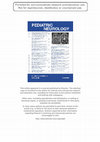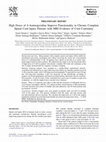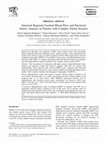Papers by EFRAIN SANTIAGO-RODRIGUEZ

Clinical EEG and neuroscience, Jan 11, 2016
The rate of premature births has increased in the past 2 decades. Ten percent of premature birth ... more The rate of premature births has increased in the past 2 decades. Ten percent of premature birth survivors develop motor impairment, but almost half exhibit later sensorial, cognitive, and emotional disabilities attributed to white matter injury and decreased volume of neuronal structures. The aim of this study was to test the hypothesis that premature and full-term infants differ in their development of emotional face processing. A comparative longitudinal study was conducted in premature and full-term infants at 4 and 8 months of age. The absolute power of the electroencephalogram was analyzed in both groups during 5 conditions of an emotional face processing task: positive, negative, neutral faces, non-face, and rest. Differences between the conditions of the task at 4 months were limited to rest versus non-rest comparisons in both groups. Eight-month-old term infants had increases (P ≤ .05) in absolute power in the left occipital region at the frequency of 10.1 Hz and in the rig...

Seizure
To evaluate the number of seizures and interictal epileptiform discharges (IEDs) in patients with... more To evaluate the number of seizures and interictal epileptiform discharges (IEDs) in patients with focal neocortical epilepsy before, during and after rTMS. Twelve patients (seven men and five women, mean age 29.3+/-15.8 years) were studied. An open-label study with baseline (4 weeks), intervention (2 weeks) and follow-up (8 weeks) periods was carried out. Repetitive transcranial magnetic stimulation (rTMS) with 900 pulses, intensity of 120% motor resting threshold and 0.5Hz frequency was used. A 120 channel EEG was recorded; an electrical source analysis of IEDs with Variable Resolution Electromagnetic Tomography (VARETA) was performed. The number of seizures per week and IEDs per minute were measured and compared in the three periods. During the basal period the mean seizure frequency was 2.25 per week; in the intervention period it decreased to 0.66 per week (F=2.825; p=0.0036) which corresponds to a 71% reduction. In the follow-up period the mean frequency was 1.14 seizures per w...

Clinical EEG and Neuroscience, 2014
Periventricular leukomalacia (PVL) is characterized by necrosis of the cerebral white matter in t... more Periventricular leukomalacia (PVL) is characterized by necrosis of the cerebral white matter in the dorsolateral portions of the lateral ventricles. PVL causes motor, sensory, and cognitive deficits. The aim of this study was to analyze the conduction characteristics of the visual pathway in infants with diffuse PVL using visual evoked potentials (VEPs). We studied 11 healthy infants (mean age 3.3 ± 1.3 months) and 17 with diffuse PVL (mean age 2.9 ± 0.8 months and mean gestational age 31.9 ± 3.1 weeks). The N75, P100, and N135 wave latencies; the interwave N75-P100 and P100-N135 latencies; and the N75-P100 and P100-N135 amplitudes were measured in the occipital leads. VEPs were recorded during binocular stimulation at an angle of 120′ from the Fz-Oz lead. Healthy children had mean N75, P100, and N135 wave latencies of 84.4 ± 5.8, 143.4 ± 30.6 and 222.9 ± 40.4 ms, respectively. The mean interwave N75-P100 and P100-N135 latencies were 59.0 ± 28.6 and 79.5 ± 13.6 ms, respectively. Com...
Gaceta Medica de …, 2002
Inadequate compliance is a major contributor to unsuccessful treatment in epilepsies. To establis... more Inadequate compliance is a major contributor to unsuccessful treatment in epilepsies. To establish risk factors associated with therapeutic non-compliance in patients with epilepsy, we carried out a case-control study, nested into a cohort, with thirteen ...
Background: Periventricular Leukomalacia (PVL) affects white matter, but grey matter injuries hav... more Background: Periventricular Leukomalacia (PVL) affects white matter, but grey matter injuries have also been reported, particularly in the dorsomedial nucleus and the cortex. Both structures have been related to working memory (WM) processes. The aim of this study was to compare behavioral performances and EEG power spectra during a visuospatial working memory task (VSWMT) of toddlers with a history of PVL and healthy toddlers.
Neuroradiology, 2006
In a study of 160 infants with prenatal and/or perinatal risk factors for brain damage, we observ... more In a study of 160 infants with prenatal and/or perinatal risk factors for brain damage, we observed three cases of schizencephaly. All cases were unilateral, and the clefts had open lips. In two cases, magnetic resonance angiography showed occlusion or absence of the middle cerebral artery (MCA) on the affected side. Two of the patients, including one with absent flow in the MCA of the affected side, had ipsilateral cerebellar atrophy.

Clinical EEG and neuroscience : official journal of the EEG and Clinical Neuroscience Society (ENCS), 2006
This report is a 2-year follow-up to a previous study describing positive behavioral changes and ... more This report is a 2-year follow-up to a previous study describing positive behavioral changes and a spurt of EEG maturation with theta/alpha neurofeedback (NFB) training in a group of Learning Disabled (LD) children. In a control paired group, treated with placebo, behavioral changes were not observed and the smaller maturational EEG changes observed were easily explained by increased age. Two years later, the EEG maturational lag in Control Group children increased, reaching abnormally high theta Relative Power values; the absence of positive behavioral changes continued and the neurological diagnosis remained LD. In contrast, after 2 years EEG maturation did continue in children who belonged to the Experimental Group with previous neurofeedback training; this was accompanied by positive behavioral changes, which were reflected in remission of LD symptoms.
Clinical Eeg and Neuroscience, 2002

Pediatric Neurology, 2009
Periventricular leukomalacia is characterized by damage to the brain's white matter and impairmen... more Periventricular leukomalacia is characterized by damage to the brain's white matter and impairments in motor function. Motor-evoked potentials by transcranial magnetic stimulation evaluate corticospinal tract function. We analyzed alterations in motor-evoked potentials in newborns with periventricular leukomalacia. Thirty infants (aged 4.37 ± 1.1 months mean ± S.D.) were divided into three groups: 10 healthy, and 10 with focal and 10 with diffuse periventricular leukomalacia. Potentials recorded in the right abductor pollicis brevis of healthy infants indicated a total motor conduction time of 26.3 ± 2.4 ms, central motor conduction time of 17.0 ± 2.6 ms, and central motor conduction velocity of 12.3 ± 2.2 m/s. In the tibialis anterior, total motor conduction time was 27.4 ± 2.6 ms; central motor conduction time was 16.7 ± 2.8 ms, and central motor conduction velocity was 25.2 ± 3.4 m/s. In the focal periventricular leukomalacia and diffuse periventricular leukomalacia groups, an increase in central motor conduction time and a decrease in central motor conduction velocity (P < 0.05) were evident, without differences between the two groups. Motor-evoked potentials in periventricular leukomalacia revealed an increase in central motor conduction time and a decrease in central motor conduction velocity, without differences between diffuse and focal types. Ó
PLOS One, 2012
Background: Approximately 2-4% of newborns with perinatal risk factors present with hearing loss.... more Background: Approximately 2-4% of newborns with perinatal risk factors present with hearing loss. Our aim was to analyze the effect of hearing aid use on auditory function evaluated based on otoacoustic emissions (OAEs), auditory brain responses (ABRs) and auditory steady state responses (ASSRs) in infants with perinatal brain injury and profound hearing loss.
International Journal of Audiology, 2010
Seizure-european Journal of Epilepsy, 2008
17, 437-445 www.elsevier.com/locate/yseiz KEYWORDS Juvenile myoclonic epilepsy; Idiopathic genera... more 17, 437-445 www.elsevier.com/locate/yseiz KEYWORDS Juvenile myoclonic epilepsy; Idiopathic generalized epilepsy; Polyspike and wave complexes; qEEG

Archives of Medical Research, 2010
Many patients with complete spinal cord injury (SCI) exhibit demyelinated and poorly myelinated n... more Many patients with complete spinal cord injury (SCI) exhibit demyelinated and poorly myelinated nerve fibers traversing the lesion site. Conventional doses of 4-aminopyridine (4-AP, 30 mg/day) have shown to provide no or minor functional improvement in these patients. We undertook this study to test the functional effect of high doses of 4-AP on patients with chronic complete SCI with cord continuity at the site of injury demonstrated by magnetic resonance imaging.Fourteen patients were included in a double-blind, randomized, placebo-controlled trial followed by an open label long-term follow-up. Initially, patients received 4-AP or placebo orally, with 4-AP being increased gradually (5 mg/week) to reach 30 mg/day. For long-term treatment, 4-AP was increased 10 mg periodically according to negative electroencephalogram and blood test abnormalities and minor adverse reactions. Pre-treatment, 12 and 24 weeks of the controlled trial, and 6 and 12 months of open trial evaluations, or with the highest doses reached were obtained.Three of 12 patients were able to walk with the assistance of orthopedic devices, 1/12 became incomplete (AIS B), 7/12 improved their somatosensory evoked potentials, 5/12 had sensation and control of bladder and anal sphincters, and 4/9 male patients had psychogenic erection.Positive changes were seen mainly in patients with cyst (4/5) or atrophy (3/5) of the injury site. Two patients withdrew from the study: one had seizures and one had intolerant adverse reactions. We conclude that high doses of 4-AP in the studied population produced several functional benefits not observed using lower doses.

Pediatric neurology, Jan 1, 2005
Infants with perinatal brain injury present impairments in motor, visual, auditory, and cognitive... more Infants with perinatal brain injury present impairments in motor, visual, auditory, and cognitive functions. The most useful methods for detecting auditory alterations are auditory brainstem responses and otoacoustic emissions. Auditory steady-state responses have been reported as a reliable and objective technique for evaluating the hearing threshold. Auditory brainstem responses and auditory steady-state responses were carried out in 53 infants with perinatal brain injury and abnormal neurologic findings. With auditory brainstem responses, 33 (62.26%) infants presented normal and 20 abnormal results; 8 (15.09%) exhibited mild alterations, 8 (15.09%) moderate, and 4 (7.54%) severe alterations. With auditory steady-state responses, 17 (32.0%) infants were normal and 36 (67.9%) had abnormal results. When auditory steady-state responses were compared with auditory brainstem responses gold standard, the assessment gave 100% sensitivity, 51.51% specificity, 55.55% positive predictive value, and 100% negative predictive value. Abnormalities were mild in 21 (39.6%) infants, moderate in 10 (18.9%), and 5 (9.4%) exhibited severe hearing loss. We conclude that hearing loss is a frequent abnormality in infants with perinatal brain injury, and auditory steady-state responses have a high sensitivity for detecting hearing impairment, which is more evident in mild hearing loss for specific frequencies.
Seizure, Jan 1, 2006
CITATIONS 15 READS 28 6 authors, including:

Archives of medical …, Jan 1, 2006
Background. Recently, new methods of EEG source analysis have been developed. Dipole modeling and... more Background. Recently, new methods of EEG source analysis have been developed. Dipole modeling and brain distributed source analysis localize in three-dimensions the origin of the electrical source of spikes registered in EEG. With single photon emission computed tomography (SPECT), it is possible to detect hypo-and hyperperfusion zones. Our aim in this study is to compare the regions where the electrical sources are detected, with the hypoperfusion regions in patients with complex partial seizures (CPS). Methods. The concordance of localization with dipole analysis, brain distributed source analysis and regional cerebral flow blood in patients with CPS was studied. The hypoperfusion zones detected with interictal SPECT were compared with electrical sources localized with brain electric source analysis (BESA) and brain distributed source analysis with variable resolution electromagnetic tomography (VARETA). Results. Hypoperfusion zones were found to localize with the origin of dipoles in 18 cases (90%), between lobes in 17 (85%) and between mesial or lateral regions in the temporal lobe in 12 cases (60%). With VARETA, agreement between side of hypoperfusion and electrical current source localization was found in 18/20 cases (90%), with lobes in 17 (85%) and with mesial or lateral regions of the temporal lobe only in 2 cases (10%). Conclusions. Hypoperfusion zones in interictal SPECT of patients with CPS are in agreement with the origin of dipoles in 85% of the cases, but in specifics zones of temporal lobe the agreement falls to 60%. The concordance of hypoperfusion zones was better with dipole analysis than with VARETA. Ó 2006 IMSS. Published by Elsevier Inc.
Applied …, Jan 1, 2007
CITATIONS 24 READS 118 12 authors, including:

Clinical EEG ( …, Jan 1, 2002
The precision between dipole Brain Electric Source Analysis (BESA) and brain distributed Variable... more The precision between dipole Brain Electric Source Analysis (BESA) and brain distributed Variable Resolution Electromagnetic Tomography (VARETA) models for the localization of brain sources of interictal epileptiform discharges in patients with partial complex epilepsy was compared. The localization of brain sources calculated with dipole analysis and variable resolution electromagnetic tomography in 20 interictal recordings was analyzed. The origin of the dipoles was temporal in 18 cases, frontal in 1 and occipital in another. One dipole was enough in 7 cases, whereas two dipoles were necessary in 13 cases. The localization of paroxysmal activity was the same with BESA and VARETA in 17 patients. BESA and VARETA are useful methods for EEG sources analysis; BESA has more precision for the localization of punctate epileptogenic regions, and VARETA provides more information concerning the extension of the epileptic zone.










Uploads
Papers by EFRAIN SANTIAGO-RODRIGUEZ